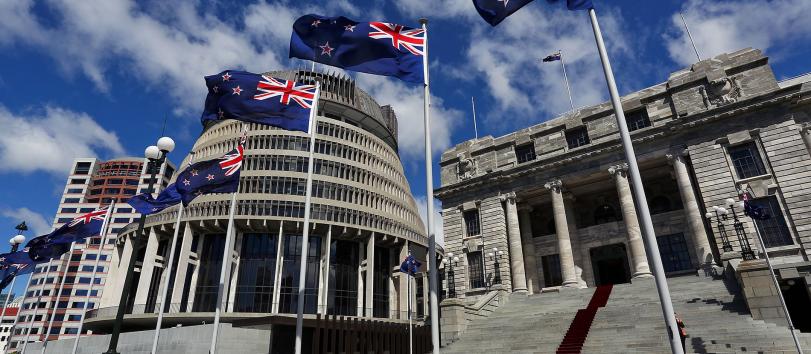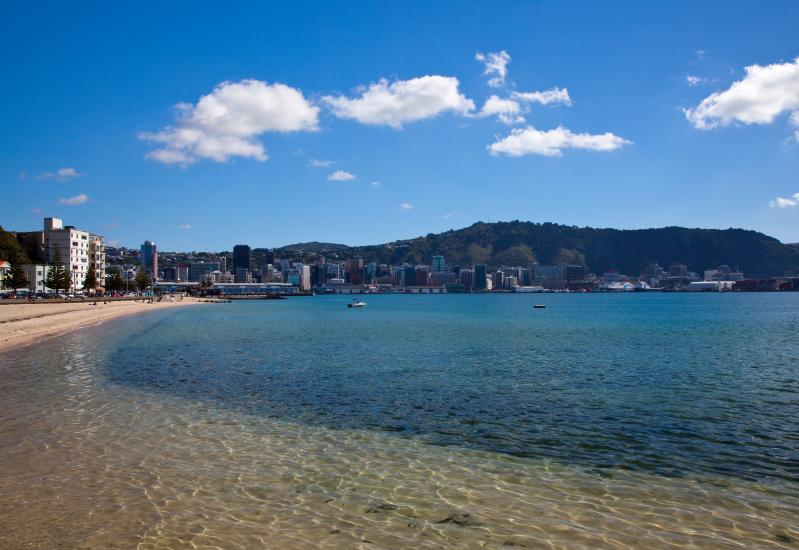
Wellington: coffee, beer and food, food, food
Wellingtonians pride themselves on being connoisseurs of all things gastronomical, fancying themselves the equivalent of the residents of New York’s Brooklyn or London’s East Side.
From ballet to fashion to art to birds to parliament to gardens – Wellington's got it all (just try to get it on a good day).
One of the hangovers from the days of Wellington as the metropolis of the middle-aged is that the Royal New Zealand Ballet and the New Zealand Symphony Orchestra are based here.
The Opera House and the nationally famous Downstage and Circa Theatres have been supplemented by others such as Bats Theatre and the Fringe Comedy Bar.
In recent years, Wellington has also played host to the eye-popping pageant that is the World of Wearable (WoW) Arts Festival.
While WoW’s organisers decided it had got too big for Nelson, where it started out, Wellington seemed the logical place for it to call its new home. The capital has embraced it, to the extent where it seems it was always part of our cultural landscape.
One of Wellington’s more famous sons, a certain Sir Peter Jackson, has done quite well for himself in the cinema, and the legacy of his success has largely transformed Wellington. Miramar, near the airport, has become an internationally renowned hub of the post-production industry, thanks to one of Sir Peter’s companies, Weta Workshop. Tours of the Weta Cave, a museum of Weta’s astounding achievements in movie-making magic, are a highlight of any visit to Wellington. Sir Peter and his fellow Weta founder, Sir Richard Taylor, were also instrumental in the renovation of the Embassy Cinema downtown, and of the glorious Roxy Cinema in the heart of Miramar’s movie district as well.
Wellington is also home to New Zealand’s national museum, Te Papa Tongarewa. It’s a world-class museum, in the modern idiom of museums, which means that it has always polarised opinion. It features interactivity over the kind of dusty, static display of the Victorian model of heritage presentation: the major exhibitions it hosts – such as the recent one commemorating New Zealand’s involvement in the Gallipoli campaign – are gobsmacking. And the building, right on the waterfront and surrounded by the newly renovated Kumutoto wetland, is striking, whatever your final view on its architectural merits.
The commemorations of World War 1 also provided the perfect excuse for the upgrade of New Zealand’s national war memorial museum, too, which is now surrounded by a pleasantly grassed precinct complete with memorial statues. This new facility hosted the very moving centennial ANZAC Day service, although the annual ANZAC service is traditionally held beneath the cenotaph just outside the grounds of parliament.
Naturally enough for a capital city, Wellington is also home to the National Library and the National Archives of New Zealand.
You might suppose these to be boring repositories of pointlessly hoarded arcana, but you’d be surprised. In fact, you’d be very surprised indeed. Both hold some remarkable material, and they’re happy to share: both hold regular, brilliantly curated exhibitions. National Library underwent a recent renovation, and as a result, the building has become a visitor attraction in its own right.
And if it’s architecture you’re keen on, Old Saint Paul’s church, right next to the Archives, is worth a look, as is Old Parliament Buildings, the southern hemisphere’s largest wooden building, constructed completely out of timber to resemble an opulent stone building – another entry in the Great Big Book of Silver Linings from the 1855 earthquake. Across the road, there are the current parliament buildings and the iconic Beehive. A tour of Parliament is always worth doing, especially if the House is sitting, and contains more than a couple of dozen somnolent members testing below the table as someone drones their way through the third reading of a Bill relating to the inspection of plastic dinnerware at the border, or somesuch.

And for the nautically minded, Wellington’s Museum of City and Sea, in the old Harbour Board buildings on the waterfront, is a fascinating window into the city’s rugged pioneering past, when most of our doings were by sea and fortunes were won and lost in the teeth of a gale.
Wellingtonians often look a little sheepish when visitors ask: so what’s the best thing to do on a day out in Wellington? They’ll mumble about Te Papa, the zoo (which is well worth a visit) and then sort of run out of ideas. But what we lose sight of is that some of the best things to do in the world’s coolest little capital are the things we do every day and therefore take for granted, lucky buggers that we are. Hanging out on the waterfront on a sunny day is one. Shopping (for those so inclined) is a joy downtown, with most of the city’s major retailers concentrated along a single ‘golden mile’. The iconic department store, Kirkcaldie and Stains, has been bought out by Aussie retail giant, David Jones, but they have retained the store’s flavour and even made it better.
A stroll through the Botanical Gardens is another great way to spend time, especially when the tulips are in flower, or when the summer concert series is in full swing.
Just up the hill (or one of the hills) from town is Zealandia, a ground-breaking nature preserve where a ‘mainland island sanctuary’ for native fauna has been established. Surrounded by a predator-proof fence, species that haven’t been seen or heard on the mainland for 200 years are flourishing: the hihi (stitchbird), the tīeke (saddleback), for example, to say nothing of the kākā, tūī, kererū and korimako (bellbird). So successful has the sanctuary been in re-establishing the birdlife that Karori residents have been known to write to the newspaper to complain about being woken by the dawn chorus. No one for kilometres around the sanctuary has been able to harvest walnuts as Zealandia’s resident kākā population fans out through suburbia. Their raucous cawing and shrieking can be heard at all hours of day or night as these great big, green-brown parrots go in search of mischief and mayhem to get into. To visit Zealandia is to get the kind of glimpse of the strange, primal and heavily bird-infested pre-history of our beloved isles that you could only get by visiting an offshore island, supposing you were permitted to do it.
If you’re feeling adventurous, you can go mountain-biking on any of the many excellent trails around the city: Mākara Peak, a short drive from town, has an array of tracks to suit all abilities and ambitions, and bike hire is available. And from Mākara Peak, the Skyline Walkway follows a high ridge to Mount Kaukau, from which panoramic views of Wellington and Cook Strait are available, and finishes at Johnsonville. You can bike the walkway, or run or (get this) walk it. Other brisk walks (and bike rides) are Mount Kaukau itself, Northland Hill or Mount Victoria through the Town Belt, the sanctuary perimeter (which takes in Brooklyn Hill, a small mountain, really, topped by an impressive wind turbine and giving breathtaking views), and Johnsons and Wrights Hills.

If you’re after something more sedate, you can walk, jog or bike around the waterfront from Oriental Bay to Evans Bay, and extend the excursion around the harbour foreshore to the South Coast, past the Wahine Memorial (which commemorates the tragic consequences of a particular bad spell of Wellington weather: see below), all the way around to Ōwhiro Bay and beyond, to Red Rocks, where you’ll almost certainly see a few fur seals lounging about on the rocks.
In summer (year round, if you’re tough and have a good wetsuit), Lyall Bay is a nice, mellow surf spot, with a quality point break along the wall beside the airport runway, and a decent beach break besides.
Around the corner, Houghton’s Bay offers a big, occasionally violent wave. Further around again, Island Bay is a sheltered swimming spot and features a snorkelling trail to showcase the bounty of the marine sanctuary that was declared along this stretch of coast in 2008. The scuba diving out here is superb, too, and a significant underwater attraction is the wreck of the frigate Wellington, which was scuttled in 2005 precisely to serve this purpose. If you want to experience some of the delights of the undersea without getting wet, visit the Baithouse, otherwise known as the Island Bay Marine Education Centre, on a Sunday. You’ll get up close and personal with all manner of aquatic critters without ever risking running out of air.
Most of the activities mentioned above are outdoors, and this inevitably brings us to the subject of Wellington’s weather. The civic slogan is ‘You can’t beat Wellington on a good day’, which alerts you to the very many days on which you can beat Wellington. It’s usually quite windy, but only when it’s not very windy. Sometimes it rains, too (although because most of our weather comes from the west, the worst of the fronts that afflict the west coast of both islands are depleted when they reach the city if they don’t pass it by altogether. But one thing the city’s climate is seldom accused of is being nondescript.
When it packs up, it packs up, and a southerly front (or ‘buster,' as they’re known) in Wellington is an experience in itself.
Some of these have become the stuff of legend, such as the Wahine storm in 1968, a day on which Wellington not only could be beaten, but positively took a beating and in which a large, modern, well-found and crewed vessel, the MV Wahine was overwhelmed and sank with the loss of 53 lives. But once a southerly front passes over, it’s as though the world has been through a carwash. The sky is a particularly vivid shade of blue, the sun is more sparkly than usual and the air is a special kind of clear. Usually, there’s no wind at all, and as you bask in these conditions, you’ll find it hard to disagree: you can’t beat the place on a good day, a day like this.